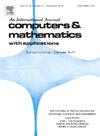精确预测复合材料纵向弹性模量的混合模型
IF 2.9
2区 数学
Q1 MATHEMATICS, APPLIED
引用次数: 0
摘要
本研究提出了一种新型混合模型,该模型将基于物理的经验模型与人工神经网络(ANN)相结合,可准确预测压缩复合材料的纵向弹性模量。研究重点是一种在 ABS 塑料基体中含有孔隙的复合材料,探讨了各种孔隙的体积、方向和形状。作为拟议混合模型的一部分,在 MATLAB® 中训练了一个回归型神经网络,用于预测和纠正基于广义刚度公式(GSF)的均质化建模方法与所收集的压缩实验测试结果之间的差异。使用 MATLAB® 神经网络,随机误差数据集用于训练前馈神经网络,其余误差数据集用于验证所提混合建模方案的性能。混合模型性能优越,平均误差 (ME) 最低,为 0.1684864;平均绝对误差 (MAE) 最低,为 1.051846;平均平方误差 (MSE) 最低,为 3.500952;R 方最高,为 0.998797。所提出的混合模型的性能优于广义刚度公式(GSF)和独立的 ANN 模型。预测精度的大幅提高凸显了混合方法在复合材料建模中的新颖性和稳健性。此外,这种方法还可用于完善任何现有的物理模型,重点是改进这些已建立的模型,使其与实验结果相匹配并减少差异,从而为精确预测提供更有效、更有吸引力的策略。本文章由计算机程序翻译,如有差异,请以英文原文为准。

A hybrid model for accurate prediction of composite longitudinal elastic modulus
This research presents a novel hybrid model that integrates a physical-based empirical model with an Artificial Neural Network (ANN) to accurately predict the longitudinal modulus of elasticity for composites under compression. The study focuses on a composite material with a pore inclusion within an ABS plastic matrix, exploring various pore volumes, orientations, and shapes. As part of the proposed hybrid model, a regression-type neural network was trained in MATLAB® to predict and correct discrepancies between the Generalized Stiffness Formulation (GSF) homogenization-based modeling method and the collected compression experimental test results. Using MATLAB® neural network, random error datasets were used to train the feed-forward neural network, and the remaining error datasets were used for validating the performance of the proposed hybrid modeling scheme.
The hybrid model demonstrated superior performance, achieving the lowest Mean Error (ME) of 0.1684864, Mean Absolute Error (MAE) of 1.051846, Mean Squared Error (MSE) of 3.500952, and highest R-squared of 0.998797. The proposed hybrid model outperformed both the Generalized Stiffness Formulation (GSF) and standalone ANN models. The significant improvement in prediction accuracy underscores the novelty and robustness of the hybrid approach in composite material modeling. Furthermore, this method can be used to refine any existing physical model by focusing on improving these established models to match experimental results and reducing the discrepancies, which offers a more efficient and attractive strategy for accurate predictions.
求助全文
通过发布文献求助,成功后即可免费获取论文全文。
去求助
来源期刊

Computers & Mathematics with Applications
工程技术-计算机:跨学科应用
CiteScore
5.10
自引率
10.30%
发文量
396
审稿时长
9.9 weeks
期刊介绍:
Computers & Mathematics with Applications provides a medium of exchange for those engaged in fields contributing to building successful simulations for science and engineering using Partial Differential Equations (PDEs).
 求助内容:
求助内容: 应助结果提醒方式:
应助结果提醒方式:


